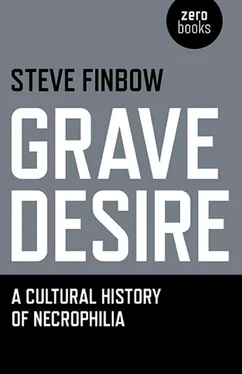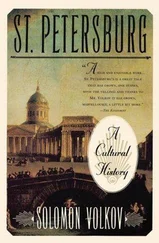Although female necrophiles are rare, they do exist, most having a morbid fascination with death and an erotic inclination to the material of death. In 2012, a 37-year-old woman in Sweden was arrested and charged with having sexual contact with a human skeleton. Investigators discovered human bones, skulls at her apartment in Gothenburg along with CDs with titles such as My First Experience and My Necrophilia which contained images of the woman using a skeleton for sexual purposes, a practice that the police described as “unethical”. The skeleton was found to be at least 50 years old, and she had purchased the assortment of bones over the internet. The woman’s obsession with death, she also collected images of morgues and cemeteries, became so intense that she needed to fulfil her desire to experience necrophilia albeit with a skeleton rather than a corpse.
Obsessive love and erotic proximity must still surmount the mucky reality of a dead body, as Freud notes, ‘One would be inclined to see disgust as one of the powers which have imposed boundaries upon the sexual goal… The strength of the sexual drive enjoys actively overcoming disgust.’ [76] The Psychology of Love, p. 130.
Taboos are cultural indicators, inhibitors, operating and shuttling between the sacred and the uncanny, the religious and the unclean, the spirit and the body, the metaphysical and the sexual; base boundaries of the Judeo-Christian moral and ethical system. ‘You shall not’—a Decalogue of taboos defining human actions and events, instrumental in forming individual conscience and societal morality. [77] See Sigmund Freud, ‘Totem and Taboo and Other Works,’ The Complete Psychological works of Sigmund Freud, Vol. 13, trans. James Strachey (London, 2001).
For some civilizations, boundaries collapse, a taboo becomes a fetish, the unclean object transformed and transferred from disgust to desire, the individual perversion becomes a societal one, the transgressor escapes punishment, the crime transmutes into custom, the prohibited is apotheosized.
From the first until the eighth century CE, the Moche people of the northern Peruvian coast fashioned jewellery and ceramics, built pyramids and farms, their technology incorporated sophisticated irrigation systems and weaving methods, and they based their religion on human sacrifice and ritual cannibalism. When archaeologists in the 1990s excavated Huaca de la Luna (Pyramid of the Moon) and Huaca del Sol (Pyramid of the Sun), they found murals showing a horrifying multi-limbed and many-fanged god whom they dubbed the Decapitator, plus pottery depicting horrific scenes of war, death, and sex—sometimes all three. There were also images of Moche priests slitting throats, the gouts of blood collected in bowls and imbibed, living people and excarnated bodies copulating in a fleshed and defleshed orgiastic ritual, several pots show a woman masturbating a skeleton. The Moche used this ritualistic necrophilia as a means of fertility-rite time travel, procreation in time and space, where ‘the context of the tomb puts sex into the house of the dead, expanding reproductive time far back into the past-and forward toward the future.’ [78] See Mary Weismantel, ‘Moche Sex Pots: Reproduction and Temporality Ancient South America,’ American Anthropologist, Vol. 6, No. 3, September 2004, pp. 495-505.
The pots depict anal wormholes (vaginal sex is rarely depicted) of desire and death, procreation and annihilation in which disgust is eradicated, made sacred, and masturbating corpses are used as a means of transferring bodily fluids, transforming death, the skeleton’s semen holding the life force that transgresses the human body in its corporeal form. Likewise, in sixteenth-century Europe, Hans Baldung Grien’s painting Death and Woman (1518-20) and Niklaus Manuel Deutsch Death and the Maiden (1517) and his Dance of Death fresco in Berne (1516-19) all depict women consorting with skeletons.
1200 years later, Marvel Comics’ Jack Kirby created a supergod Thanos who ‘courted Death itself in the alluring form of a robed, hooded, voluptuously breasted female figure,’ [79] Grant Morrison, Supergods (London 2011), p. 136.
an erotic siren, a Playboy centrefold sporting the double-Ds of death and desire. In other Marvel Comics editions, Death appeared the instant before someone dies, taking the form of a lover. At Captain Marvel’s death, it materialized as his greatest love Una (truth).
Returning to other superheroes and demigods, during the Trojan war (ca. 1194–1184 BCE), the Amazon warrior Penthesileia, seeking atonement after unintentionally killing her sister Hippolyte while firing an arrow at a stag they were hunting, vows to kill the Greek hero Achilles. After slaughtering many men, including Podarces, she comes to blows with Telemon Ajax before battling Achilles, the noble son of Peleus impaling her and her wind-swift horse with his host-destroying spear. As the bodies lie quivering in the dust, Achilles removes the Amazon’s war helmet and is ensorcelled by the goddess-like beauty of the daughter of the war god Ares. Wishing he had taken her for his bride, he falls upon the body in remorse and lust, and later kills his fellow Achaean Thersites for calling him a ‘perverted man.’ [80] Quintus of Smyrna, The Trojan Epic: Posthomerica, trans. Alan James (Baltimore, 2007), pp. 3-24.
Taken from an historical account by Phylarchus (third century BCE), Parthenius of Nicaea, the last of the Alexandrian poets, writes in his Erotica Pathemata (of the sorrows of love—circa first century BCE) of Dimoetes who married Evopis the daughter of his brother Troezen. But the girl loved another, her own brother. When Dimoetes discovered that the siblings were having sex, he told his brother. Terrified and stigmatized, the young girl put a noose around her neck and, damning Dimoetes, hanged herself. Maybe eroticized by the suicide, Dimoetes, walking along the beach, saw the body of an extremely beautiful woman roiling in the surf; he dashed in and pulled her to the shore. He fell in love with her and took the corpse back to his dwelling where his desire overwhelmed him and he had sex with the dead body. He kept her as long as he could, but the body began to deliquesce and disintegrate, and, finally, the putrescence became too much and he interred her in an opulent tomb. Even then, his passion would not abate and, his sexual obsession with a corpse undimmed, he killed himself with his own sword. [81] Parthenius, Love Stories 2, http://www.theoi.com/Text/Parthenius2.html#31 . See Pierre Grimal, The dictionary of classical mythology (Oxford, 1996), p. 137.
Achilles, Dimoetes, and Carl von Cosel each honour their dead lovers with a magnificent burial, or build tombs for them—Achilles arranges for the ashes of his would-be corpse bride to be interred in King Laomedon’s tomb within the walls of Ilium. These men fall under the classification of necromantics, obsessed with their love and desire for a singular loved one, rather than erotic compulsion to have sex with corpses, as in Karen Greenlee’s case. However, in the building of tombs, Achilles, Dimoetes, and von Cosel transfer their desire to a spiritual communion with the dead—similar to Mochean culture, as a device to either disable time (von Cosel’s rebuilding of his lover’s body), or to reverse time (Achilles taking of the dreaded and warlike Penthesileia as his posthumous bride), or folding time and space as in Dimoetes’s transubstantiation (sublimation) of his incestuous wife’s hanging body with the drowned body he preserves.
Composed between the third and sixth centuries CE, the Babylonian Talmud accused King Herod the Great of necrophilia. [82] Aryeh Kasher and Eliezer Witztum, King Herod: a persecuted persecutor: a case study in psychohistory and psychobiography, trans. Karen Gold (Berlin, 2007), p. 171.
In 29 CE, after sentencing his second wife Mariamne the Hasmonean to death for alleged adultery and conspiracy to murder—an executioner strangled her with a silken cord—the repentant yet delirious and psychotic Herod had his beautiful dead wife embalmed in honey and stored in his palace for the next seven years. His sexual desire for his mellified wife remained as strong as when she was alive. The contemporary Judeo-Roman historian Titus Flavius Josephus states that, ‘His love for Mariamne seemed to seize him in such a peculiar manner, as looked like Divine vengeance upon him for the taking away her life; for he would frequently call for her, and frequently lament for her in a most indecent manner.’ [83] Flavius Josephus, Jewish Antiquities (London, 2006), p. 662.
Herod even outdid Achilles, Dimoetes, and von Cosel by building the Mariamne Tower, a sumptuous fortress palace in Jerusalem, and one of only three buildings to survive the siege and destruction of Jerusalem by the future emperor Titus Flavius Vespasianus in 70 CE.
Читать дальше












